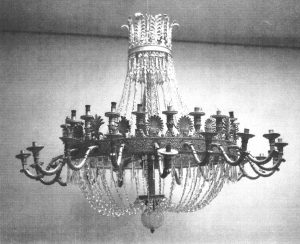
Foto 1
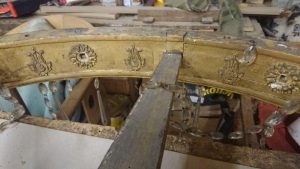
Foto 2
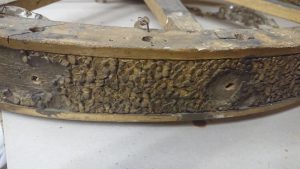
Foto 3
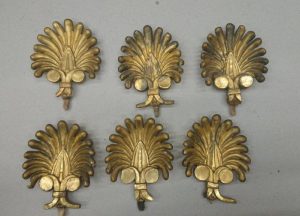
Foto 6
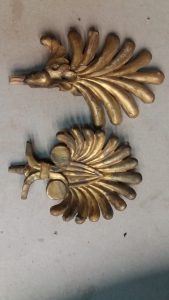
Foto 5
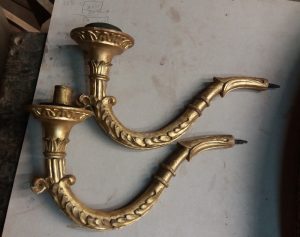
Foto 4
Ein Kronleuchter aus dem Wiener Schloss Weinhaus – Suche nach ähnlichen Kronleuchtern, Zofia Maciakowska, Gdansk/Danzig
Die Sammlung des Museums im Jaroslaw Orsettihaus, Polen (http://www.muzeum-jaroslaw.pl/) umfasst Objekte aus dieser Stadt sowie aus der Umgebung. Viele von ihnen wurden nach dem Zweiten Weltkrieg aus nahe gelegenen Herrenhäusern und Palästen dem Museum übergeben, weil diese Gebäude neuen Zwecken dienen sollten. Unter ihnen sind mehrere Leuchter aus dem frühen 19. Jahrhundert.
Ein einzigartiges Objekt ist ein hölzerner vergoldeter Kronleuchter, der einst im Czartoryski Palast in Pełkinie, Polen hing. (Foto 1, heutiger Zustand). (https://www.jaroslawski.pl/en/the-manor-houses-trail/the-palace-complex-in-pelkinie ) Gemeinsam mit den Mitgliedern der Familie Czartoryski hat er einen langen Weg von Wien zurückgelegt.
Konstanty Adam, Fürst Czartoryski (1773-1860) soll ihn für das als Weinhaus bekannte Wiener Schloss gekauft haben, welches er 1832 erworben hatte. Der Leuchter wurde angeblich auf Bestellung des Vorbesitzers – Henry Wellesley, 1. Baron Cowley (1773-1847), englischer Botschafter in Wien – angefertigt, der aus unbekanntem Grund vom Kauf zurücktrat.
Seine Gestaltung und Dekoration knüpft an Projekte von Karl Friedrich Schinkel (1781-1841) an. Er bestand aus Bekronung, großem Reifen und unterem Abschluss (siehe Foto 2 und 3). Am Reifen mit einem Durchmesser von etwa 100 cm, wurden außen zwanzig s-förmige Arme (Foto 4) befestigt. Auf dem Reifen sind über jedem Arm Palmetten platziert (Foto 5 und 6) und dazwischen zwanzig weitere Kerzenarme mit Tüllen. So konnten gleichzeitig 40 Kerzen brennen. Der Schaft ist mit Akanthusblättern dekoriert. An seinem unteren Ende befindet sich eine Scheibe, an welcher der Bas-de-lustre, eine geschliffene Glasskugel, sowie die am Reifen hängenden 40 Ketten aus facettierten Rautenbuchteln befestigt waren. Ähnliche Ketten hingen von der Bekronung zum Reifen. Zwischen den Glassketten befanden sich Eisbirnel. Auch die Bekronung war mit stilisierten Palmetten dekoriert, welche den oberen Abschluss bildeten. An ihm hängen Kopfprismen.
Jerzy Konstanty Fürst Czartoryski (1828-1912) verkaufte das Schloss 1912 an die Wiener Gemeinde, weil es bei der geplannten Straßenregulierung abgerissen werden sollte. Er ließ einige Elemente der Innenausstattung abbauen und brachte sie nach Schloss Pełkinie (Polen). Unter diesen Objekten war auch der beschriebene Leuchter, der auf den Fotos des Weinhauses von 1909 noch in seinem ursprünglichen Zustand sichtbar ist. Zwei Fotos des Leuchters vor der Änderung:
https://digital.onb.ac.at/rep/osd/?10BD3D82
https://onb.digital/result/10BE0835
Die bescheideneren Dimensionen vom Inneren des Schlosses in Pełkinie, machten es notwendig, den oberen Teil, inklusiv den Glassketten zu kürzen. Deshalb ist er nur noch 150 cm hoch. In diesem Zustand hat er das Ende des Krieges überdauert.
Seit einer vor Kurzem erfolgten Bestandaufnahme der erhaltenen Elemente wird ein Restaurierungsprogramm vorbereitet. Der Erhaltungszustand der Einzelteile des Leuchters ist relativ gut. Außer den fehlenden Glasteilen der Behangketten sind nur einige Ergänzungen und die Konservierung der geschnitzten und vergoldeten Holzteile erforderlich.
Ich wäre dankbar, wenn jemand Informationen ähnliche Objekte betreffend hat, welche Sie mit mir teilen könnten und ich würde mich freuen von Ihnen zu hören. Wenn sie helfen könnten, schicken sie bitte Ihre E-Mail an das Sekretariat: office@lightandglass.eu
A Chandelier from the Viennese Schloss Weinhaus – A Search for similar chandeliers. Zofia Maciakowska, Gdansk/Danzig
The collection of the Museum in Jaroslaw Orsetti House in Poland (http://www.muzeum-jaroslaw.pl/) includes objects from the town as well as from the surrounding area. Many of them were transferred to the museum after World War II from nearby mansions and palaces, because the purpose of these buildings changed after the war. Among them are several chandeliers from the early 19th century.
A unique object is a gilded wooden chandelier that once hung in the Czartoryski Palace in Pełkinie, Poland. (Photo 1, present condition). (https://www.jaroslawski.pl/en/the-manor-houses-trail/the-palace-complex-in-pelkinie ) Together with the members of the Czartoryski family, it traveled a long way from Vienna.
Konstanty Adam, Prince Czartoryski (1773-1860) is said to have bought it for the Viennese palace known as the Wine House (Weinhaus), which he acquired in 1832. The chandelier was supposedly made to order for the previous owner – Henry Wellesley, 1st Baron Cowley (1773-1847), English ambassador to Vienna – who withdrew from the purchase for unknown reasons.
Its design and decoration follows projects of Karl Friedrich Schinkel (1781-1841). It consists of a crown, a large hoop and a lower finial (see photos 2 and 3). Attached to the outside of the hoop with a diameter of about 100 cm, are twenty s-shaped arms (photo 4). On the hoop, palmettes are mounted above each arm (photo 5 and 6) and between them, twenty more candle arms with grommets. Thus, 40 candles could burn at the same time. The shaft is decorated with acanthus leaves. At its lower end, there is a disc to which the bas-de-lustre, a cut glass sphere, was attached, as well as the 40 chains of faceted rhomboid glass buttons hanging from the hoop. Similar chains hung from the crown to the hoop. Between the glass chains were icicle drops. The crown was also decorated with stylized palmettes, which formed the top finial. Albert prisms hang from the crown.
Jerzy Konstanty Prince Czartoryski (1828-1912) sold the castle to the Viennese municipality in 1912 because it was to be demolished due to the new street planning. He had some elements of the interior dismantled and brought them to Pełkinie Castle (Poland). Among these objects was the chandelier described, which is still visible in its original state in the photos of the wine house from 1909. Two photos of the chandelier before the changes are to be seen through these links:
https://digital.onb.ac.at/rep/osd/?10BD3D82
https://onb.digital/result/10BE0835
The more modest dimensions of the interior of the castle in Pełkinie, made it necessary to shorten the upper part, including the glass chains. This is why it is now only 150 cm high. In this condition it survived the end of the war.
Following a recent inventory of the preserved elements, a restoration program is being prepared. The state of preservation of the individual parts of the chandelier is relatively good. Except for the missing glass parts of the hanging chains, only some additions and conservation of the carved and gilded wooden parts are needed.
I would be most grateful if anyone has information regarding similar objects that they could share with me and would be happy to hear from you and receive any help regarding this special piece. Please send your e-mail via the Light & Glass secretary at: office@lightandglass.eu
No Comments, Comment or Ping
Reply to “Kronleuchter aus dem Wiener Schloss Weinhaus / Chandelier from the Vienna Schloss Weinhaus”